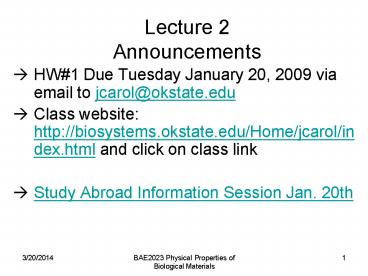Lecture 2 Announcements - PowerPoint PPT Presentation
1 / 22
Title:
Lecture 2 Announcements
Description:
Vascular Cambium: Between xylem and phloem. Provides new cells to xylem and phloem ... Cork Cambium: Outside of phloem. Prevents water loss from the interior of plant ... – PowerPoint PPT presentation
Number of Views:42
Avg rating:3.0/5.0
Title: Lecture 2 Announcements
1
Lecture 2Announcements
- HW1 Due Tuesday January 20, 2009 via email to
jcarol_at_okstate.edu - Class website http//biosystems.okstate.edu/Home
/jcarol/index.html and click on class link - Study Abroad Information Session Jan. 20th
2
Quick Review
- Why do we take this class?
- What is biomaterial?
- Should read the first chapter in your book (short
chapter!) - Today Cell Structure
- Next Friday Physical Attributes Read pgs. 11 -
20
3
Graphic www.eng.auburn.edu/.../plant_cell_struct
ure.gif
New cell wall production and motility
Formation of chemical energy, aerobic respiration
from ATP
- Cell Handout
Protein synthesis and transport, rough contains
ribosomes, smooth transports
Synthesis of proteins
Form and stability to cell, protective barrier
Synthesizes cell wall components
Selective permeable boundary between cell
contents and wall,
Cytoplasm contains organelles, transportation
synthesis functions
Plastid that contains chlorophyll,
photosynthesissunlight to energy in the form of
carbs.
Contains pectin, lignon. Provides support and
flexibility between cells
junkyard, synthetic and degradative functions
(low PH..acidic)
Assist in photosynthesis, respiration, breakdown
of trash for recycling
RNA
Contains cell genetic code, cell brain, DNA
Nucleoplasm
4
Tissues and Functions
Graphic http//users.rcn.com/jkimball.ma.ultrane
t/BiologyPages/P/PlantTissues.html
- Epidermis (Protective)
- clear covering
- outermost part of plant
- protects plant from loss of water to air
- allows gas entry and exit
- allows roots to absorb water
5
Tissues and Functions
- Parenchyma
- Found in leaves
- Either contain chlorophyll for photosynthesis or
store food - Collenchyma
- Found in leaves
- Support leaf or stem
6
Tissues and Functions
- Sclerenchyma
- Made of either fiber or sclerid
- Fibrous have a secondary cell wall and usually
means the cells are deadgive flexibility and
support - Sclerid more pronounced secondary wall and
provide hardnesscoverings such as nut shells
(coconuts, pecans..)
7
Tissues and Functions
Graphic http//users.rcn.com/jkimball.ma.ultrane
t/BiologyPages/R/Roots.html
- Endodermis
- One layer thick
- Found in root system
- Direct water and minerals from soil to
controlling plant tissue
8
Tissues and Functions
Graphic http//users.rcn.com/jkimball.ma.ultrane
t/BiologyPages/R/Roots.html
- Primary Xylem
- Combination of 4 cell types
- Vessel elements
- Tracheids
- Fibers
- Parenchyma cells
- All die except parenchyma when they mature
- Responsible for water transport in plant,
vertical and horizontal movement
9
Tissues and Functions
Graphic http//users.rcn.com/jkimball.ma.ultrane
t/BiologyPages/R/Roots.html
- Primary Phloem
- Four cell types
- Sieve tube
- Companion cells
- Fiber cells
- Parenchyma cells
- Storage and lateral transport of food materials
10
Graphic www.eng.auburn.edu/wfgale/usda_couse/se
ction0_images_2/syle
- Vascular Cambium
- Between xylem and phloem
- Provides new cells to xylem and phloem
- protects plant from loss of water to air
- Cork Cambium
- Outside of phloem
- Prevents water loss from the interior of plant
- Protects interior from environmental extremes
- Example tree bark
11
Cellular Respiration
6CO2 6H2O Light Energy C6H12O6 6O2
- Goal
- Convert carbon-containing compounds into energy
for life processes - Carried out in the mitochondria
- Two Types
- Aerobic uses oxygen as electron acceptor
- Anaerobic uses other compounds for cellular
respirtaion - Both types start with glycolysis
12
Glycolysis
- Occurs in the cytoplasm
- Takes a molecule of glucose (6 carbon sugar
molecule) - Converts it to pyruvic acid
- Changes in molecules happen because of enzymatic
activity - Enzymes protein molecules that facilitate
reactions - Involves energy (use, production)
13
Anaerobic Respiration
- Electron acceptor is NOT oxygen.
- AKAFERMENTATION
- Two types of fermentation lactic acid and
alcoholic
14
Aerobic Respiration
- Majority of organisms respire aerobically
- Terminal electron acceptor is oxygen
- Consists of 2 processes
- Krebs (aka Citric Acid) Cycle
- Electron transport chain
- Krebs Cycle produces CO2 and H2O
- Electron Transport transports electrons!!!
- From high energy compounds to lower energy
compounds - Final receptor is oxygen molecules
15
Respiration
- Aerobic respiration is more efficient at
producing energy for the plant - Some organisms (known as facultative anaerobes or
aerobes) can do either kind of respiration - Example yeast
- With oxygen, use citric cycle and et to produce
their energy - Without oxygen, use alcoholic fermentationproduce
ethyl alcohol
16
Photosynthesis
- Heterotrophs consume their energy
- Autotrophs produce their own food
- Plants are autotrophs
- Use sunlight, water, and carbon dioxide to form
carbohydrates and oxygen
17
Photosynthesis
- Light Reactions
- Photosystem I absorbs sunlight by chlorophyll
molecule - Photosystem II converts two water molecules
into electrons, protons, one water molecule and ½
oxygen molecule. - Electron transfer releases energy
- Oxygen is either used in the cycle or given off
through respiration
18
(No Transcript)
19
Photosynthesis
- Dark Reactions
- Do not require light
- AKA carbon fixation reactions
- Carbon from CO2 is used to make sugars like
glucose - Requires light reaction products (NADPH) and CO2
20
Photosynthesis
- Requires
- light for Light Reactions
- Water for electron and proton source
- Proper temperature for efficiency
21
HW2 Assignment Due 1/23/09
- Explain the parts of an animal cell and the
differences between plant and animal cells - Include graphic(s) of animal cells
- Include functions of the cell parts
- Put your answer in the form of a Power Point
- Email it to jcarol_at_okstate.edu by midnight on
1/23.
22
Resources
- http//sun.menloschool.org/cweaver/cells/
- http//cals.arizona.edu/pubs/garden/mg/botany/phys
iology.htmltranspiration - http//www.eng.auburn.edu/wfgale/usda_course/sect
ion0_2_page_3.htm































